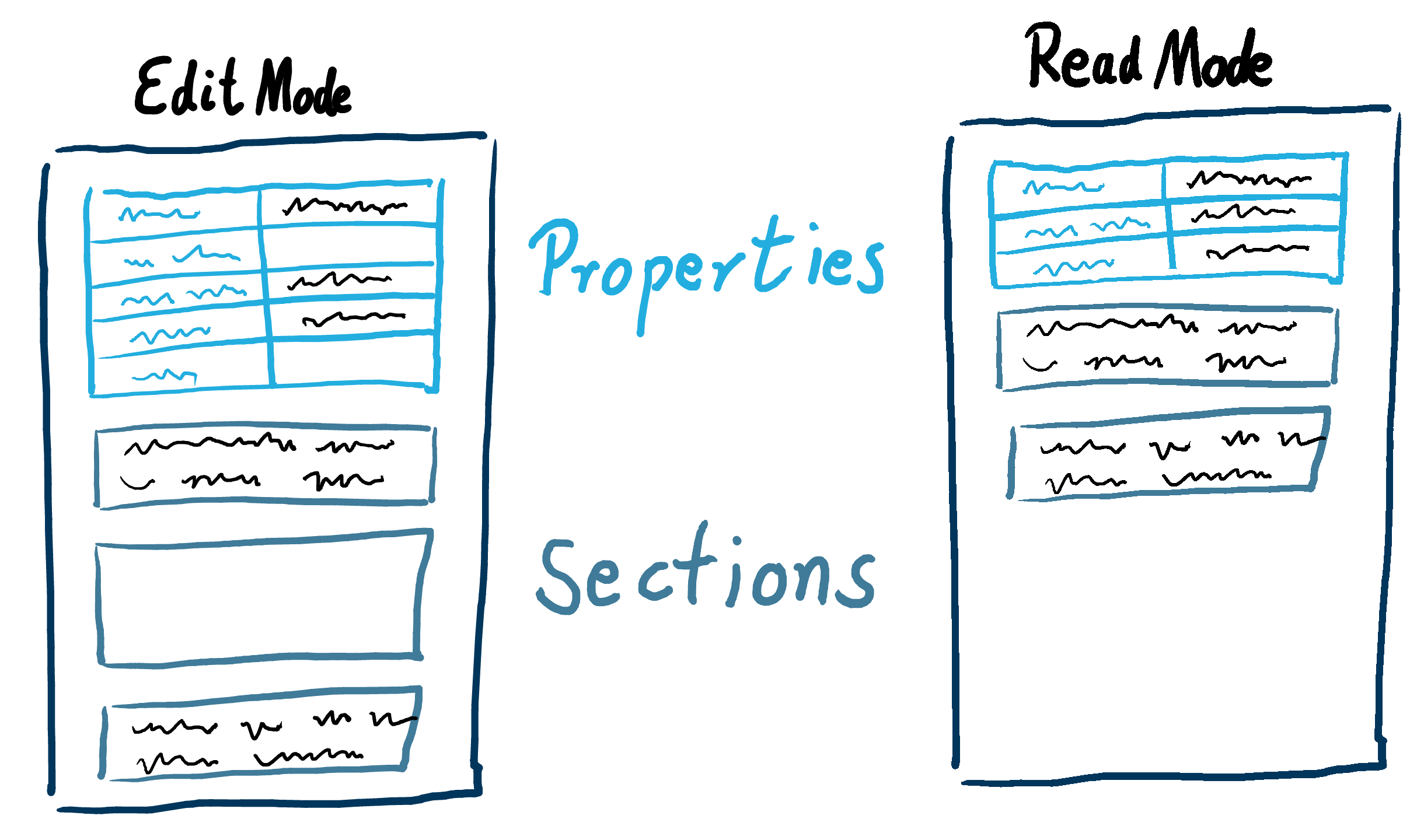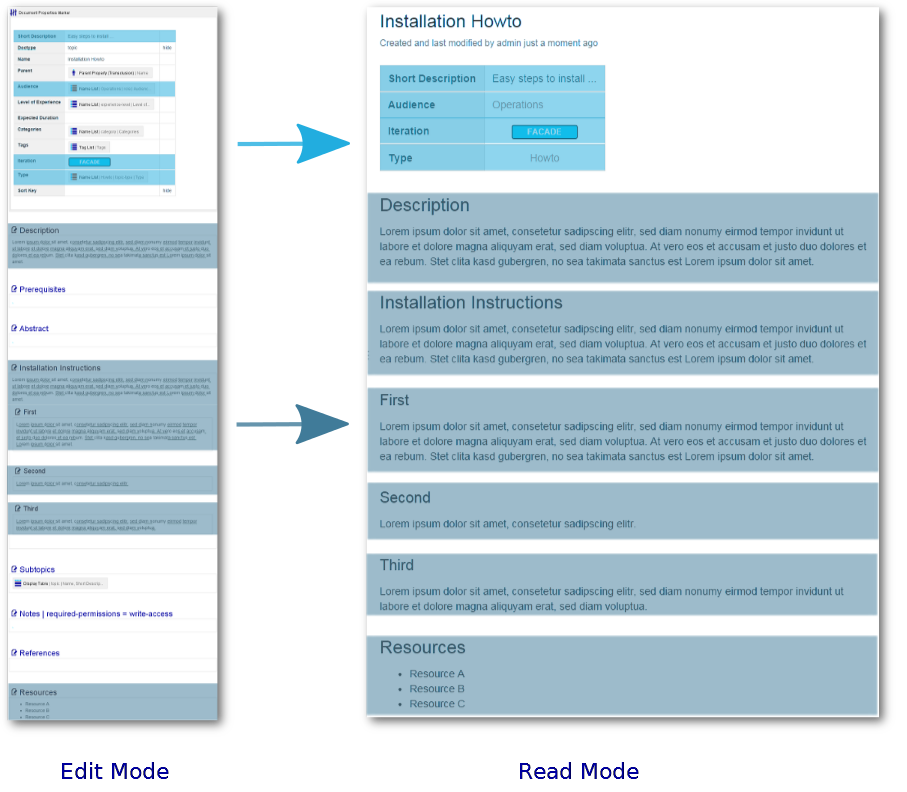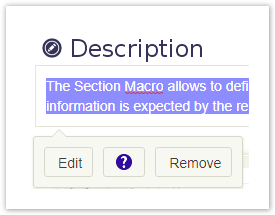- Created by Robert Reiner, last modified on 18. Nov 2022
projectdoc Toolbox
Do not clutter the view with non-information sections. Instead help authors writing identical structured content by the use of templates.
A template typically puts a demand on the author: fill out everything! Or remove what you did not fill out now! Neither is appreciated. The authors have a set of information in their minds they want to contribute. Maybe the document is created collaboratively. Certainly it is created iteratively. This especially applies to project documentation, where the team writes for the team. In this case the documentation is typically never finished. Rather the documents are in different states of the iteration cycle. Yet the information provided is already relevant for other team members. Do we want our readers to be confronted with empty sections only attached to a decoy title? Do we add value by some decoy text like "TBD"? On the other hand, if the boiler plate parts are removed, we have no access to them when we or other teammates need it.
The result of this feature is that an author is provided with support adding relevant information at the expected positions and also has guidance according to what information may be relevant for my audience for this kind of document. On the other hand the reader is only seeing section with actual content. The same is true for properties.
- Properties are only rendered, if they provide a non-blank value
- Sections are only rendered, if the body has actually content

As a screenshot this feature looks like this:

In edit mode the authors have access to the structure that is defined by the template. The authors decide which information they need to add to the document and stores it at the defined locations. They may add any number of additional properties or sections. Any properties or sections that are not yet (or never relevant), are left empty. Once the document is saved, only those properties and sections are presented to the reader that actually contain relevant information. On the left side there is the view of an editor with sections that have content or have no content. On the right side you see what reader's see in view mode. Sections with no content are not rendered.
The Section Macro allows to define possible information for a given doctype at a defined position within the document. Typically this section contains text supporting the author to know which information is expected by the reader for each section. The Section Macro also allows to link to more information by the use of the help button (marked with the image of a question mark ).

Resources
More information on this feature.
- Section Macro
- Renders a section, if the body is not empty. Supports authors to create content, clutter-free rendering without empty sections. Allows to transclude the content.
- Documentation JSON URI
- The URI to a JSON document containing the URLs to the documentation for the blueprints.
- DocumentationMap
- Stores the documentation map to link to doctype documentation.
- Content Marker Macro
- Marks a piece of content within a document. This content can be referenced for transclusion.
- Document Types
- Document types allow to guide authors producing information of a given type. They also help readers to find the information they are looking for quickly.
- Extensible by Spaces, Templates, and Macros
- Never be limited to the vendor's ideas: Create your own spaces, templates/blueprints/doctypes and macros based on components provided by the projectdoc Toolbox!
More Features
List of features of the projectdoc Toolbox for Confluence.
- Deep Links
- With deep links properties from referenced properties can be accessed for rendering.
- Default Locations
- Document types have their default location within a documentation space. These default locations are called 'homepages'. If authors create new documents they can send them to these default locations within a given space. Delegate spaces expand this feature to find the default location in associated spaces.
- Delegate Document
- Delegating documents transclude sections and properties from a delegate document. Information may be overridden.
- Document Types
- Document types allow to guide authors producing information of a given type. They also help readers to find the information they are looking for quickly.
- Dynamic Linking
- A document template that uses query macros enables documents to dynamically render links to a set of related documents. If new documents are added to the system that meet the query criteria, links to these documents are automatically added to the querying document. This feature is also called dynamic lists or automatic linking.
- Enhanced Transclusion
- Transclude more than one self-contained snippet and mark transcluded information for authors. The projectdoc toolbox allows multi-transclusion from one document and even several documents.
- Extensible by Spaces, Templates, and Macros
- Never be limited to the vendor's ideas: Create your own spaces, templates/blueprints/doctypes and macros based on components provided by the projectdoc Toolbox!
- Information Systems Integration
- Via a free extension information from remote information systems may be rendered on a wiki page.
- Live Templates / Impersonator
- Use the structure from a page and render it in the current page's context.
- Remote Control
- The projectdoc Toolbox supports rendering a page controlled by request properties. This way a URL controls the contents of a page.
- Rich Custom Document Metadata
- Authors may add any metadata to a document and use these in their queries. The metadata may be displayed or hidden. This way authors can use metadata target at the reader and metadata used for authoring purpose.
- Single Sourcing
- The projectdoc Toolbox provides doctypes and macros to support teams to modularize their documentation.
- Space Hierarchies
- Organize spaces in hierachies with delegate and search spaces.
- Space Properties
- Properties may be set on space level and are inherited through space hierarchies.
- Variables
- Space and document properties may be used as variables with the projectdoc Toolbox.
- Web API
- To integrate projectdoc documents with remote systems the projectdoc Toolbox provides a REST API. This API is installed separately with a free extension add-on.




